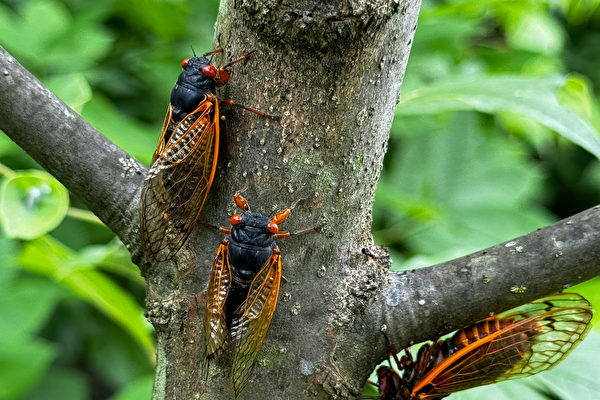“Great Epoch News May 24, 2024” – “Cicadas! Cicadas! Cicadas!” Two cicada armies that only meet once every 221 years are rampaging in the United States, with numbers reaching into the billions or even trillions. It can be imagined that when these loud singers raise their voices together, it will surely bring a very noisy summer to the locals.
This year, a total of 17 states are facing cicada invasions. The two armies are divided into two fronts: the 19th Brood XIX, which has been lurking underground for 13 years, is mainly responsible for sweeping the Southeast, while the 13th Brood, which has been underground for 17 years, is advancing into the Midwest.
There are over 3,000 species of cicadas globally, but only 9 species belong to the periodical cicadas, with 7 species found in North America. Unlike annual cicadas, the nymphs of periodical cicadas spend much longer underground, usually 13 or 17 years.
According to USA Today, once the soil temperature 8 inches below ground reaches 64 degrees Fahrenheit, they emerge, with many states beginning in April and May, continuing until late June.
This is the first time since 1803 that the two cicada armies have appeared in the United States, and it is expected to bring an exceptionally noisy summer to the country. Just watching these videos will show how “scary” the situation is (Video 1, Video 2). And these are just the vanguards of the massive cicada armies, with the main forces yet to come.
The last time these two cicada armies gathered in the U.S. was in 1803 when Thomas Jefferson was president. That year, the U.S. purchased Louisiana from France.
Currently, most cicadas are either molting or still climbing up, bustling lively on the American soil.
According to the Cicada Safari tracking app developed by Saint Joseph Mount University in Cincinnati, Ohio, the 19th Brood XIX is completing molting, mobilizing in full force in the Midwest and Southeast states.
Their presence spans Alabama, Arkansas, Georgia, Illinois, Kentucky, Mississippi, Missouri, North Carolina, Oklahoma, South Carolina, Tennessee, and Virginia.
According to the tracking service, the 13th Brood has started appearing in Wisconsin, the entire Chicago area, and near Peoria, Illinois. According to Agence France-Presse, the two armies may overlap in a small area in Central Illinois.
After spending more than 10 years underground, periodical cicadas have a lifespan of only three to six weeks on the ground. Once male and female periodical cicadas mate and lay eggs, they die a few weeks later.
This means many of this year’s periodical cicadas will die in June, some might die at the end of May or in July, depending on when they emerge from the ground.
According to the Missouri Department of Environmental Protection, the nymphs of annual cicadas stay underground for 2 to 5 years. These cicadas are called “annual cicadas” because every year, some of their members emerge from the ground, shedding their muddy exoskeletons to enjoy the fleeting summer on the ground.
Many people may not know that the persistent singers of “Cicadas! Cicadas! Cicadas!” in the summer are all male cicadas. According to the Encyclopedia Britannica, male cicadas synchronize their calls to establish their territories and attract female cicadas. They also emit mating calls before mating.
The 13 and 17-year periodical cicadas have the largest voices, partially due to their greater numbers appearing simultaneously.

